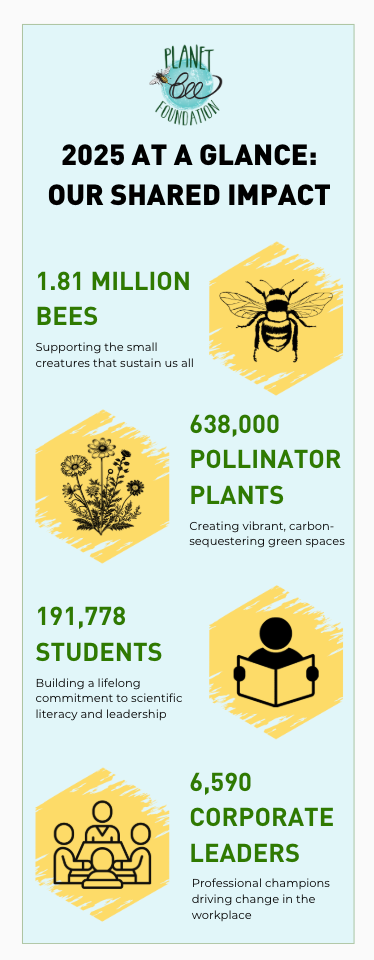The Importance of Eco-Literacy in Schools
- Planet Bee Foundation

- May 1, 2023
- 4 min read

It is now more crucial than ever to create awareness about climate change and foster ownership of the environment. Many countries - and continents - are addressing climate change through strategic efforts, such as eco-literacy in schools. Some of these countries include Sweden, Japan, and The Netherlands. Of course, the curriculum and level at which this subject is taught differ from country to country and school.
Several institutions in the United States, such as The Center for Eco-Literacy, work with K-12 schools across the US to introduce eco-literacy into their curriculum and help outline the standards students should achieve. As part of their initiative, The Center for Eco-Literacy has established a program in California known as the California Food for California Kids network. This initiative helps schools build their capacity to provide locally grown ingredients used in the cafeteria. Through this initiative, children build relationships with the garden through the school's cafeteria.
Online communities, such as the MotherhoodCommunity, help to identify pertinent issues like these and others, and create awareness around them, to help all mothers make more informed decisions about everyday matters.
Why is Eco-Literacy Important in Schools?
Incorporating eco-literacy into the school curriculum from an early stage will help to teach students about the environment, give children a sense of ownership over their environment, and develop intrinsic values regarding sustainability.
While climate change and sustainability practices are serious topics, these themes can be introduced through interactive learning programs that allow children to participate in these initiatives and programs, thus giving them a sense of ownership. For example, each child in a classroom can be given a seed to grow, soil, and a pot to grow their plants. To further promote sustainability, these initiatives could include a variety of vegetable seeds and types of biodiversity and allow each child to choose which vegetable or plant they want to grow. At the end of the semester, children can present their project to the class and discuss the challenges they faced during the growth cycle of their chosen vegetable or plant. Of course, a teacher will be assisting the children with information throughout the season.
When children know how to plant seeds, grow, and care for plants, they will attain a sense of achievement when their seedlings mature into fully grown plants. This sense of completion and a feeling of success will foster a love for plants and an understanding of the need for biodiversity.
Another school in the California district adopted a project where students spent the entire semester building an underwater ecosystem using paper drawings. When the teacher placed black bags over the ecosystem to symbolize an oil spill, the children were eager to learn how to save "their environment." This speaks volumes about involving children in interactive activities that allow a child to take ownership of their environment.
Similarly, by taking children out on field trips in nature, the child learns firsthand the importance of biodiversity and the need to create a sustainable future for all life forms on earth. Visiting a nearby sustainable farm is a great way to expose children through education to the need for awareness.
It's essential to foster a love for nature and teach children to understand sustainability practices. These factors will play a critical role in how children grow up to address these issues. Children are the future and climate change is a reality today. For children to have a world to thrive in as adults, they must learn how to protect that world from a young age. The sooner eco-literacy is introduced into their curriculum, the sooner children will adopt an attitude of ownership.
Taking A Page from China's Book
China is considered one of the most significant global contributors to greenhouse emissions. However, several projects, including introducing eco-literacy in schools on a national scale, prove that China is taking active, strategic steps to address climate change. The introduction of eco-literacy in schools aims to create a continent with a reduced carbon footprint and citizens who actively promote sustainability and awareness of climate change.
Another initiative promoted in the Chinese city of Shanghai is the "no waste city" project. The project aims to encourage the recycling of waste at the city level. All residents are required to have recycling bins in their homes. All materials should be correctly disposed of. Ten cities in China have been selected for this project, which started in 2018.
So how do the United States and other countries differ from the approach that China has taken? While many countries have initiated programs to some degree and at some level in schools, few have yet to introduce eco-literacy at a national level in all grades. Governments should work with relative stakeholders to develop comprehensive educational curriculums that address eco-literacy from a young age.
By making the program fun and interactive, young students will quickly become engaged and demonstrate an understanding of nature, the ecosystem, and the role of human beings in protecting the planet. In addition, young children learn through interaction. Introducing eco-literacy from a young age may also promote healthy habits and a healthy lifestyle.



